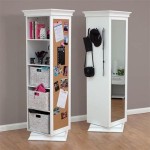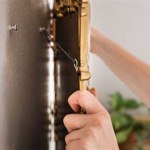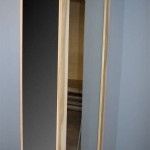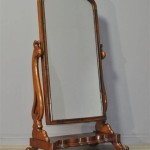How To Hang A Large Frameless Mirror With Adhesive
Hanging a large frameless mirror presents unique challenges compared to framed counterparts. The absence of a frame removes a natural mounting point and increases the risk of damage if the mirror is dropped or improperly secured. Adhesive mounting systems offer a sleek, modern look and eliminate the need for visible screws or wires, but require careful planning and execution for a successful installation. This guide provides a comprehensive step-by-step process for safely and securely mounting a large frameless mirror using adhesive.
Preparing the Wall Surface
Proper wall preparation is crucial for successful adhesion. An inadequately prepared surface can lead to weak bonding, resulting in the mirror falling and potentially breaking. Follow these steps to ensure the wall is ready:
- Clean the wall thoroughly with a mild detergent and water. Grease, dust, and other debris can interfere with the adhesive's bond.
- Allow the wall to dry completely. Moisture can weaken the adhesive and prevent proper curing.
- If the wall has a textured surface, lightly sand it to create a smoother surface for better adhesion. Wipe away any sanding dust.
- For walls painted with glossy paint, consider lightly sanding to improve adhesion. A deglosser can also be used, following the manufacturer's instructions.
Choosing the Right Adhesive
Selecting the correct adhesive is paramount for safety and longevity. The adhesive must be capable of supporting the weight of the mirror and appropriate for the wall material. Consider these factors:
- Weight Capacity: Choose an adhesive specifically designed for heavy objects, ensuring it can handle the weight of the mirror. The weight capacity should be clearly stated on the product packaging.
- Wall Material: Different adhesives are formulated for various wall materials like drywall, tile, and concrete. Select an adhesive compatible with the specific wall material.
- Mirror Backing: Check the manufacturer's recommendations for adhesives compatible with the mirror backing material.
- Temperature and Humidity: Consider the environmental conditions of the room. Some adhesives are more suitable for humid environments than others.
Measuring and Marking
Accurate measurements are essential for ensuring the mirror is positioned correctly. Follow these steps for accurate placement:
- Determine the desired height and position of the mirror on the wall.
- Use a level to draw a horizontal line on the wall where the top edge of the mirror will be placed.
- Measure the width of the mirror and mark the center point on the horizontal line.
- Using the center point as a reference, measure and mark the horizontal edges of the mirror on the line.
Applying the Adhesive
Proper adhesive application ensures a strong and secure bond. Follow the manufacturer's instructions precisely for the best results. General guidelines include:
- Apply the adhesive to the back of the mirror according to the adhesive manufacturer's recommendations. This typically involves applying adhesive in vertical lines or a grid pattern.
- Maintain a consistent distance between the adhesive lines or dots to ensure even weight distribution.
- Avoid applying adhesive too close to the edges of the mirror to prevent it from squeezing out and becoming visible.
Mounting the Mirror
Mounting the mirror requires careful handling and precise placement to avoid errors and ensure proper adhesion. Follow these steps for secure mounting:
- Carefully lift the mirror and align the top edge with the horizontal line marked on the wall.
- Gently press the mirror against the wall, ensuring the edges align with the marked positions.
- Apply even pressure across the mirror's surface to ensure full contact with the adhesive.
- If the adhesive manufacturer recommends it, use temporary supports to hold the mirror in place while the adhesive cures.
Curing Time
Allowing sufficient curing time is crucial for the adhesive to reach its full strength. Rushing this process can compromise the bond and lead to the mirror detaching from the wall. Observe the following:
- Consult the adhesive manufacturer's instructions for the recommended curing time. This typically ranges from 24 to 72 hours.
- Avoid disturbing the mirror during the curing period.
- Do not remove any temporary supports until the adhesive has fully cured.
Safety Precautions
Safety should be a top priority when handling and mounting large, heavy objects like frameless mirrors. Consider these safety measures throughout the process:
- Wear appropriate safety gear, including gloves and eye protection, when handling the mirror and adhesive.
- Enlist the help of another person when lifting and positioning the mirror to prevent accidents.
- Ensure adequate ventilation in the room while working with adhesives.
- Keep children and pets away from the area during the installation and curing process.

How To Hang A Frameless Mirror On Wall

How To Install A Mirror Without Frame Merrypad

How To Hang A Frameless Mirror On The Wall With Pictures
:strip_icc()/DesireeBurnsInteriors1-f76d25cad90041c88fbae4a7dc10aab4.jpg?strip=all)
2 Simple Ways To Hang A Frameless Mirror

How To Hang A Frameless Mirror On The Wall With Pictures

How To Install A Mirror Without Frame Merrypad

Here S How To Easily Hang A Frameless Wall Mirror

Mirror Installation Without Clips

How To Hang A Frameless Mirror On Wall

Putting Your Mirror Up With Adhesive April 2024 Our 5 Picks For The Best Adhesives








